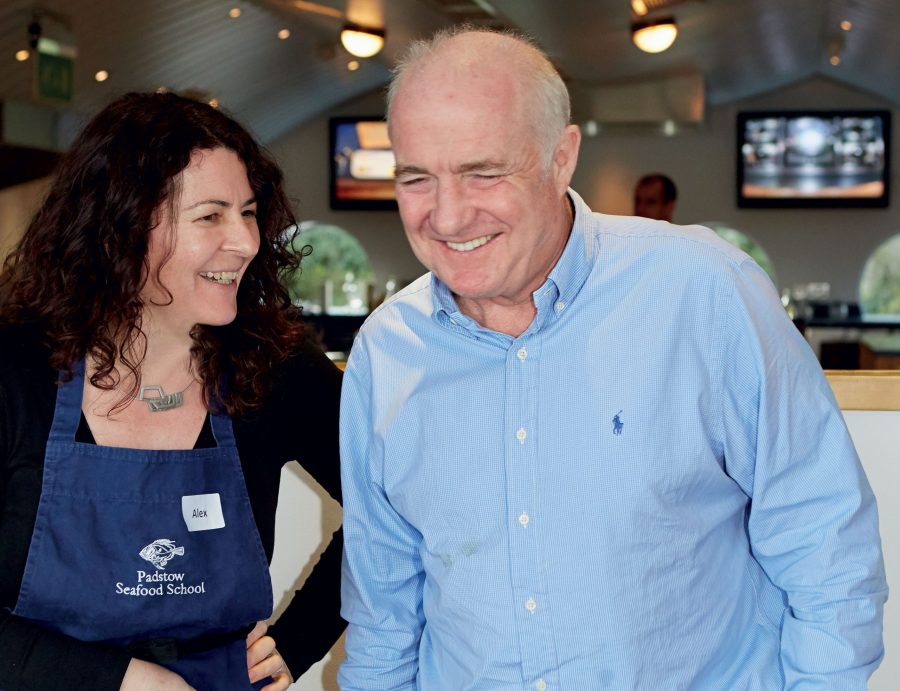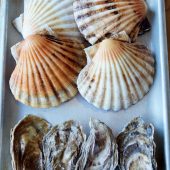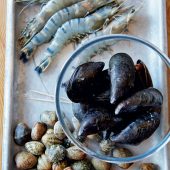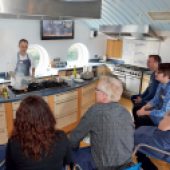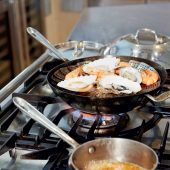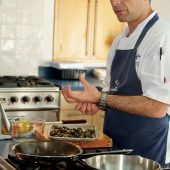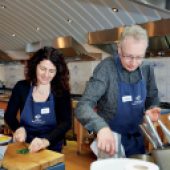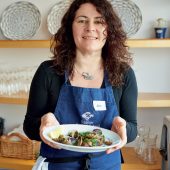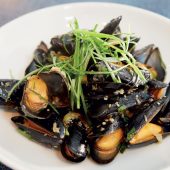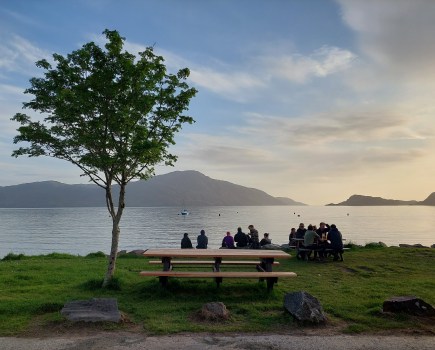Coast Editor Alex Fisher heads to Rick Stein’s Padstow Seafood School for a crash course in preparing, cooking… and tasting… shellfish. Photos: Paul Pyan-Goff
It’s nearly 40 years since Rick and Jill Stein opened their first restaurant in the small fishing village of Padstow. Having gained fame for great cooking and affable TV presenting, Rick has steadily expanded his empire to include a café, fish-and-chip shop, delicatessen, patisserie, pub, bistro and accommodation, and currently employs 350 people in Cornwall.
In 2000 he opened Padstow Seafood School in the disused fish market building on the South Quay. Here, we can now all learn the skills that have made his eateries famous around the world, from filleting fish and preparing lobster to working with chocolate and making macaroons. This year, for the first time, they are offering short courses of just a few hours: easy on the pocket and designed to appeal to holidaymakers. Our Editor, Alex, spent an afternoon on their Mussels, Clams & Oysters cookery workshop.
1.45PM GETTING STARTED
I arrive early and the sun is streaming through the window that overlooks the Camel Estuary. Trays of carefully prepared ingredients are already waiting: green herbs wrapped in damp tissue to keep them fresh, oysters and scallops in their shells, alongside ginger, lemon and huge tiger prawns. All things I love to eat, but rarely attempt to cook, believing only an expert could do justice to their delicate flavours. A large wooden table stretches out in front of the window, and I am offered a coffee and invited to wait for the other participants.
2PM PRE-COOK BRIEF
Gradually the others arrive. For some this is their third or forth cookery master class, for others it’s a first – a birthday present from a family member, an activity fitted into a holiday. Husband and wife Mark and Emmanuelle intend to have the full Rick Stein experience, with a meal at The Seafood Restaurant booked for the evening.
Our tutor for the day, Head Chef Lecturer Mark Puckey, introduces himself to the group. After a brief health and safety talk – knives are sharp, hands carry germs, seafood can make you ill…we are all given our aprons and led to a semi-circle of high stools positioned around Mark’s demonstration post.
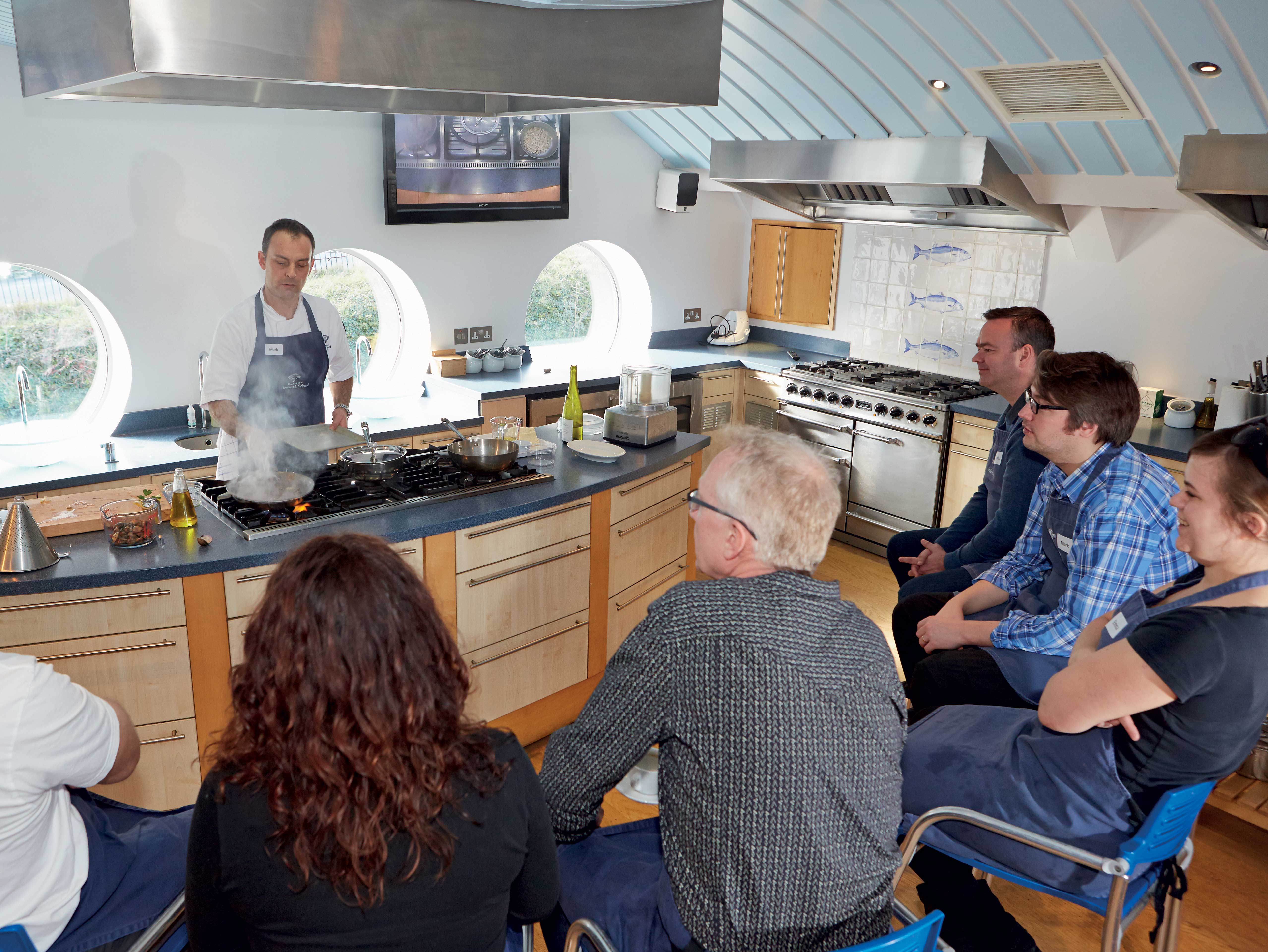
2.15PM QUICK CLAM DISH
We begin with clams. I glance up at the television screen, which shows a close-up of what’s happening on Mark’s chopping board, and try to absorb the details. Mark explains that we should check each clam individually by wiggling the shells with vigour. If loose, discard. Ours have already been cleaned for hours in water; at home clams require extensive rinsing. It already sounds tricky and the cooker isn’t even lit yet.
It takes Mark moments to prepare the first simple dish, clams a la plancha. With a flick he sets fire to the oil, which gives them a smoky, barbecued flavour. He passes the finished clams around for us to try – delicious. And now it’s our turn.
2.30PM PAIRING UP
We work in pairs and I team up with James, who seems pretty confident in the kitchen. As directed, after chopping some flat-leaf parsley, I heat a dry pan and douse the closed shells with olive oil before they hit the pan. This, Mark explains, makes them glisten. We heat the clams until they open, for just a few minutes. Then, with Mark’s encouragement, I tip the pan and the oil catches fire. It burns out before I manage to set fire to my hair, and I slip the clams on to a warmed plate, dress with a little olive oil, sprinkle with parsley and a squeeze of lemon. The dish looks and tastes great and is ridiculously simple.
3PM GIVING IT MUSSEL
Next it’s mussels. This time the dish is a little more complex, stir-fried with black bean sauce, garlic and ginger, a spicy alternative to moules marinières that we all know and love. We return to the demonstration post where Mark explains we shouldn’t throw away mussels that are closed – as many people think – rather we should reject those that are gaping open and don’t respond to cold water and a sharp tap. He shows us how to remove the skin from the ginger with a blunt spoon and take the germ out of the garlic as this can give you heartburn. Having finely chopped equal amounts of garlic and ginger, he cuts the spring onions into delicate long strips, mashes the teaspoon of black beans with a little sugar, and mixes the soy sauce, sherry and stock.
3.30PM STEIN APPROVAL
Now we have to reproduce the dish. Once the herbs and spices are prepared, we heat the groundnut oil in a wok before adding the garlic, ginger, black beans, followed shortly by the white of the spring onions. The mussels, which have been rinsed and patted dry, are added a few moments later, along with the soy sauce, sherry and stock. A rich, spicy aroma fills the air. After a couple of minutes we chuck in chopped coriander and the green of the spring onions, then serve.
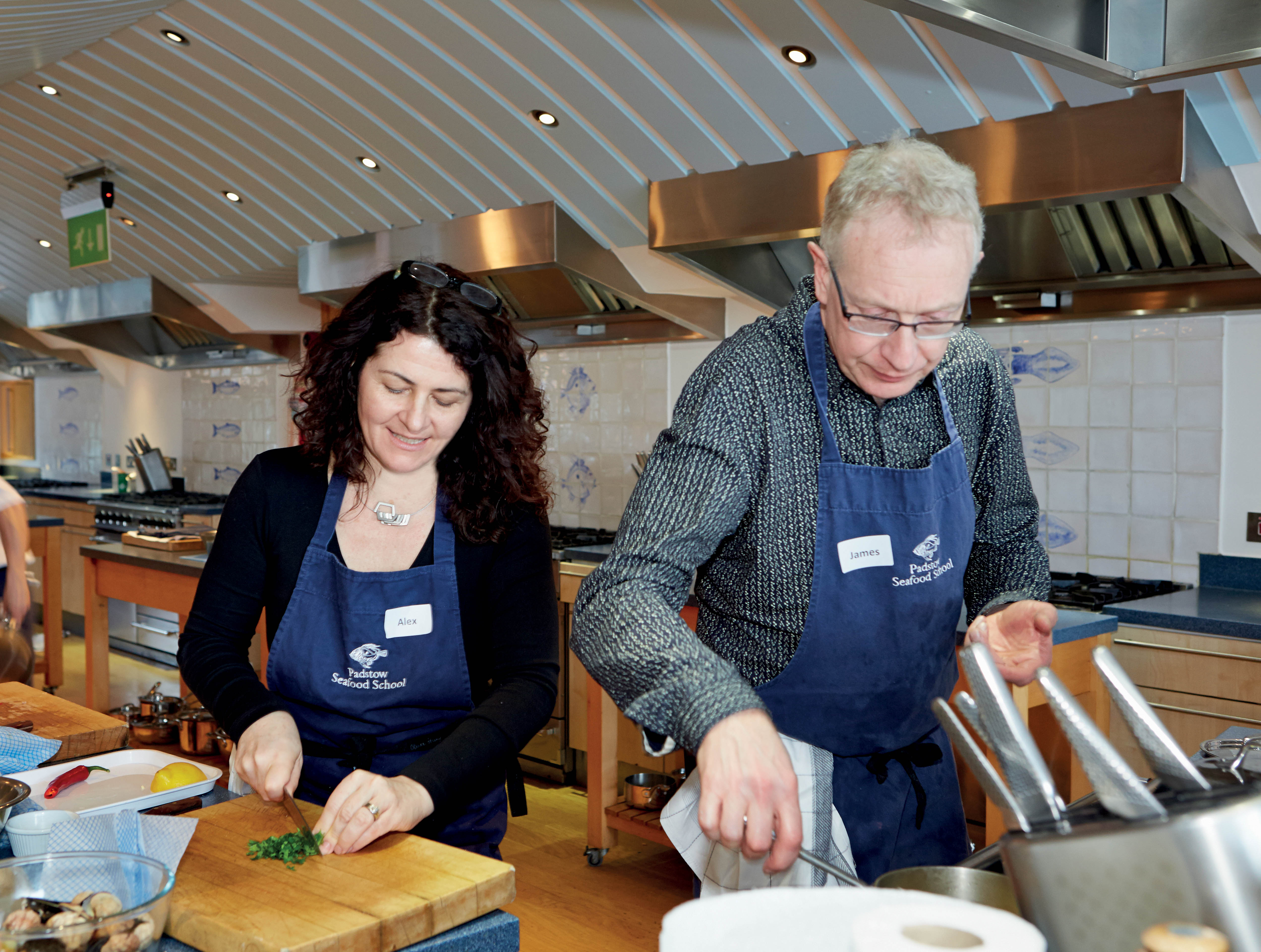
As we take our dishes to the table, the seafood legend Rick Stein himself comes to join us. ‘Would you like a taste?’ I ask. He graciously accepts one of our mussels. ‘Delicious,’ he says. You can’t argue with the master…
4PM THE FINAL RECIPE
Time for our last dish of the day. As we sit down wine is poured – a chilled Touraine, currently the house white at Rick Stein’s Café. This is good and bad; scallops are being prepared, oysters shucked, cockles washed…and I am really enjoying my glass of wine. Although tempted, I refrain from having a second and concentrate on Mark.
4.30PM OYSTER-SHUCKING
When it comes to our turn I am glad we are working in pairs. James puts the mussels in a pan with white wine and cooks them until they open, whilst I try to prepare my first oyster. With a little guidance from Mark I force the shell apart with the oyster-shucking knife. Once the oyster has been loosened with a spoon, it’s on to the scallops. I slip a straight metal spatula between the shells, trying not to damage the delicate scallop inside. When open, I pull off the frill and black stomach sack and rinse to remove any sand. Meanwhile, the liquor from all the shellfish and wine has been put into a pan with chilli, parsley, olive oil and garlic and brought to the boil. The shellfish, along with the prawns, are steamed together to heat, then arranged on a warmed plate and the dressing is added.
4.45PM TIME TO EAT!
We sit at the table, with more wine and bread, and enjoy the fruits of our labour. In three short hours I’ve learnt more about cooking than I have in the last three years. On top of that, I’ve eaten a delicious meal and had great fun. I can’t wait to try out my new skills on my friends.
For more adventure inspiration, click here or pick up a copy of the magazine.
NEED TO KNOW
HOW TO GET STARTED
Padstow Seafood School now has a wide range of cookery courses, which run throughout the year. Visit rickstein.com.
GETTING THERE
You can fly to nearby Newquay Airport from Gatwick and Manchester, then take a cab or the 556 Western Greyhound bus to Padstow. Alternatively, you could catch a train to Bodmin Parkway and then hop on a 555 Western Greyhound bus.
WHAT IT COSTS
The three-hour Mussels, Clams & Oysters course is £95. One-dish workshops start at £30 and last two hours, a four-day course is £780.
WHERE TO STAY
Rick Stein has 40 rooms within walking distance of the Seafood School, with interiors designed by Jill Stein. Prices start at £100 per room per night.
ASK THE PROS
Cornish-born Head Chef Lecturer Mark Puckey started cooking professionally as a teenager. He has been working for Rick Stein for nearly 14 years, taking up his current position in 2005.
‘The idea behind the course is to de-mystify fish and shellfish cookery. The key points to learn are not to overcook, and to keep it simple – if you use quality ingredients you don’t need to smother the dish in sauce. Also, it’s important to source your fish carefully: if it doesn’t look fresh, it isn’t. Don’t decide on a recipe and go out to get your ingredients, instead, base what you are going to cook around the freshest fish you can find that day.’

